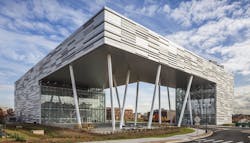Rutgers University School of Business, Piscataway, N.J.
Owner: Rutgers University, Piscataway, N.J.
Owner’s Rep: Structure Tone, New York
Design Architect: TEN Arquitectos, New York
Executive Architect: Richard Bienenfeld AIA, New Rochelle, N.Y.
*Structural Engineer: WSP, New York
General Contractor: Century 21 Construction, River Edge, N.J.
*Firm that entered the project in the IDEAS2 contest
The 150,000-sq.-ft Rutgers Business School is the gateway to Rutgers University’s Livingston Campus in Piscataway, N.J., as envisioned by the campus master plan. The L-shaped form of the building appears to float 60 feet above Rockefeller Road becoming the physical gate through which most campus traffic passes. The building is designed in keeping with the goals of the master plan towards a high-density academic development complete with urban facilities, shared amenities, and a walkable campus. Similarly, this building reflects the ongoing shift in higher education that moves away from a focus on classroom-oriented organization and towards a focus on spaces that support collaboration. This shift is especially reflective of contemporary business models where cross-collaborative ideas, cultures, and concepts create, evaluate, and market innovation.
The building is conceived as three bands -- classroom, office, and public spaces -- connected vertically by an atrium and horizontally stitched together by scaled communal spaces ranging from personal nooks to collaboration zones to collective spaces. Circulation spaces engage rather than separate the different building programs. Professors are located at the heart of the school within reach of their students becoming both resources and partners in the dynamic evolution of ideas.
The Business School, like every new construction at Rutgers University, is LEED Silver equivalent. The building is powered by solar panels located above the adjacent parking lot. The cooling and heating needs are augmented by neighboring geothermal borefields built below the quad. All stormwater is managed through bioswales and retention ponds on-site. The atrium provides high levels of day-lighting into the building and the mechanical system is optimized for lower energy usage. Low VOC materials and specialized carpet tiles enhance the air quality as well.
Structurally the building includes twelve 65-ft-long sloping columns that support the “floating” L-shaped form above. The floating L-shaped feature includes a 92-ft, column-free span. To achieve this, 60-in.-deep built-up plate girders were utilized. These 92-ft-long girders are supported by the 65-ft-long sloping columns.
In order to assure there would not be a vibration issue with the floating L-shaped portion of the building, the design team created a finite element model to study human-induced vibrations for this area. The team at WSP Structures performed a time history analysis following AISC Design Guide 11 recommendations. Based on the analysis, it was determined that the human induced vibrations would be considerably less than the acceptable vibration levels defined by the ISO chart in chapter 2 of Design Guide 11.
Thomas Murray, author of AISC Design Guide 11, visited the site before the building fit-out and façade erection to study the vibrations on the floating L-shape. With an accelerometer attached to the floor, a volunteer walked the floor at different frequencies with a metronome in hand. Based on the data collected, the floor performed exactly as predicted by the time history analysis.
Steel members also created other architectural features within the building. Exposed bracing inside the building became an architectural feature. Making sure that the lateral forces induced from wind and seismic events could get to the lateral bracing systems turned out to be a challenge. Because of the open nature of the building, numerous openings in the floor diaphragms were required. The numerous openings and the L-shaped section connecting the two parts of the building required the design team to carefully follow the load paths of the wind and seismic induced loads.
In the end, the design team assisted world renowned architect, Enrique Norton, to achieve his vision, which created numerous structural challenges for the design team, but challenges that were well worth the effort. A student or teacher walking through the building experiences an inspiring sense of openness and airiness. Every step through the building introduces the user and the visitor to a unique view. Rutgers Business School students and professors will be inspired by this incredible building for many years to come.
